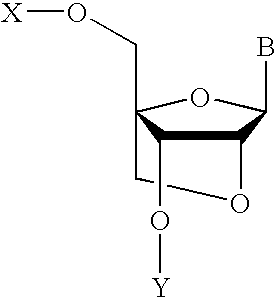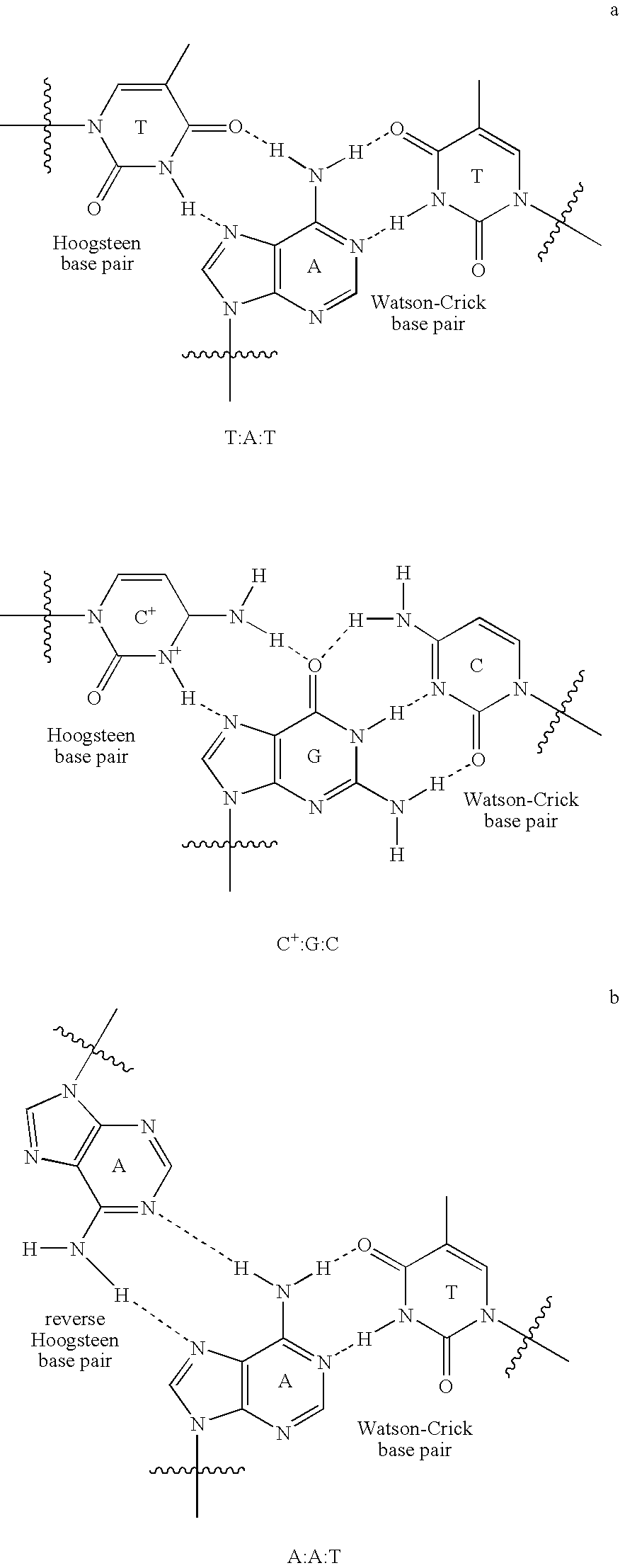Nucleoside analogs and oligonucleotide derivatives containing these analogs
a technology of nucleoside analogs and derivatives, applied in the field of polymer, can solve the problems of insufficient triplex-forming ability in the in vivo ph range, low permeation through the cell membrane, and limited targeting sequences to the homopurine tract. high efficiency and high affinity
- Summary
- Abstract
- Description
- Claims
- Application Information
AI Technical Summary
Benefits of technology
Problems solved by technology
Method used
Image
Examples
example 1
Synthesis of Nucleoside Analogues
(1) Synthesis of 1-[2-O-acetyl-3,5-O-dibenzyl-4-(p-toluenesulfonyloxymethyl)-β-D-ribofuranosyl]-2-oxopyridine (Compound 2)
[0034]In a stream of nitrogen, pyridin-2-one (52 mg, 0.52 mmol) and N,O-bistrimethylsilylacetamide (0.16 ml, 0.57 mmol) were added to an anhydrous dichloroethane solution (4 ml) of compound 1 (154 mg, 0.26 mmol), and the mixture was heated under reflux for 2 hours. Under cooling with ice, trimethylsilyltrifuoromethane sulfonate (0.051 ml, 0.28 mmol) was added, and the mixture was heated under reflux for 4 hours. After a saturated aqueous solution of sodium bicarbonate was added to the reaction solution, the system was extracted with ethyl acetate. The organic layer was washed with water and a saturated aqueous solution of sodium chloride, and then dried over anhydrous sodium sulfate. The solvent was distilled off under reduced pressure, and the resulting crude product was purified by silica gel column chromatography (AcOEt-n-hexan...
examples 2 to 4
[0044](1) to (3) of Example 1 were repeated using isoquinolin-1-one, 5-methyl-2-oxopyridine (Barash, M.; Osbond, J. M. Wikens, J. C. J. C. S. 1959, 3530), or 4-hydroxy-2-oxopyridine instead of 2-oxopyridine, thereby synthesizing 2-(2-O,4-C-methylene-β-D-ribofuranosyl)isoquinolin-1-one, 1-(2-O,4-C-methylene-β-D-ribofuranosyl]-5-methyl-2-oxopyridine, and 1-(2-O,4-C-methylene-β-D-ribofuranosyl)-4-hydroxy-2-oxopyridine (compounds corresponding to compound 4 of Example 1).
[0045]When 4-hydroxy-2-oxopyridine was used as the starting material, the steps (1) and (2) of Example 1 were performed without protecting the hydroxyl group at the 4-position, and a benzoyl group was used for protection in the step (3).
[0046]For these compounds, (4) and (5) of Example 1 were repeated, thereby synthesizing their respective amidite compounds (compounds corresponding to compound 6 of Example 1).
example 5
General Synthesis of Oligonucleotide Derivatives
[0047]Synthesis of oligomers was performed on a scale of 0.2 μmol by Pharmacia's DNA synthesizer, Gene Assembler Plus. The concentrations of solvents, reagents and phosphoroamidites are the same as in the case of native DNA synthesis. The DMTr group of 5′-O-DMTr-thymidine (0.2 pmol) having a 3′-hydroxyl group bonded to a CPG substrate was deprotected with trichloroacetic acid. For the 5′-hydroxyl group, condensation reaction was performed repeatedly using an amidite comprising 4 nucleic acid bases for native DNA synthesis and the amidites of the present invention (compound 6 of Example 1(5), or compounds of Examples 2 to 4). As a result, oligonucleotide derivatives having the respective sequences were synthesized. The synthetic cycle is as described below.
Synthetic Cycle (0.2 μmol Scale)
[0048]1) Detritylation, 1% CCl3COOH in CH2ClCH2Cl, 6 sec[0049]2) Coupling, 0.1 M phosphoramidite (25 equiv.), 0.5 M 1H-tetrazole (500 equiv.) in MeCN, ...
PUM
| Property | Measurement | Unit |
|---|---|---|
| Molar density | aaaaa | aaaaa |
| Molar density | aaaaa | aaaaa |
| Molar density | aaaaa | aaaaa |
Abstract
Description
Claims
Application Information
 Login to View More
Login to View More - R&D
- Intellectual Property
- Life Sciences
- Materials
- Tech Scout
- Unparalleled Data Quality
- Higher Quality Content
- 60% Fewer Hallucinations
Browse by: Latest US Patents, China's latest patents, Technical Efficacy Thesaurus, Application Domain, Technology Topic, Popular Technical Reports.
© 2025 PatSnap. All rights reserved.Legal|Privacy policy|Modern Slavery Act Transparency Statement|Sitemap|About US| Contact US: help@patsnap.com



